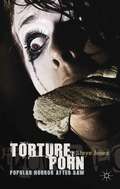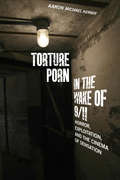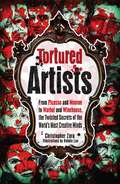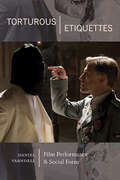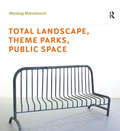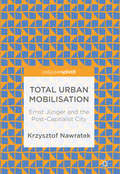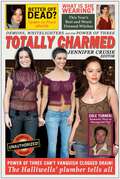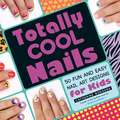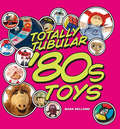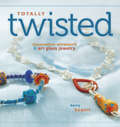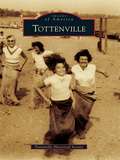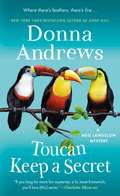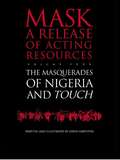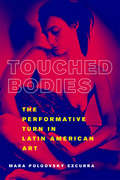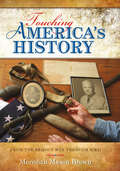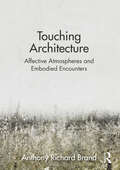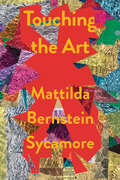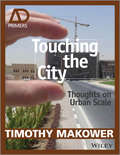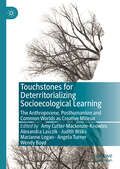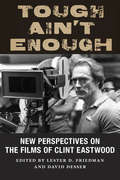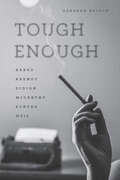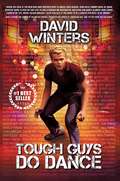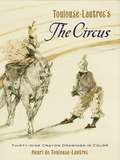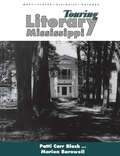- Table View
- List View
Torture Porn
by Steve JonesThe first monograph to critically engage with the controversial horror film subgenre known as 'torture porn', this book dissects press responses to popular horror and analyses key torture porn films, mapping out the broader conceptual and contextual concerns that shape the meanings of both 'torture' and 'porn'.
Torture Porn in the Wake of 9/11
by Aaron Michael KernerSaw, Hostel, The Devil's Rejects: this wave of horror movies has been classed under the disparaging label "torture porn." Since David Edelstein coined the term for a New York magazine article a few years after 9/11, many critics have speculated that these movies simply reflect iconic images, anxieties, and sadistic fantasies that have emerged from the War on Terror. In this timely new study, Aaron Kerner challenges that interpretation, arguing that "torture porn" must be understood in a much broader context, as part of a phenomenon that spans multiple media genres and is rooted in a long tradition of American violence. Torture Porn in the Wake of 9/11 tackles a series of tough philosophical, historical, and aesthetic questions: What does it mean to call a film "sadistic," and how has this term been used to shut down critical debate? In what sense does torture porn respond to current events, and in what ways does it draw from much older tropes? How has torture porn been influenced by earlier horror film cycles, from slasher movies to J-horror? And in what ways has the torture porn aesthetic gone mainstream, popping up in everything from the television thriller Dexter to the reality show Hell's Kitchen? Reflecting a deep knowledge and appreciation for the genre, Torture Porn in the Wake of 9/11 is sure to resonate with horror fans. Yet Kerner's arguments should also strike a chord in anyone with an interest in the history of American violence and its current and future ramifications for the War on Terror.
Tortured Artists: From Picasso and Monroe to Warhol and Winehouse, the Twisted Secrets of the World's Most Creative Minds
by Christopher ZaraGreat art comes from great pain.Or that's the impression left by these haunting profiles. Pieced together, they form a revealing mosaic of the creative mind. It's like viewing an exhibit from the therapist's couch as each entry delves into the mental anguish that afflicts the artist and affects their art.The scope of the artists covered is as varied as their afflictions. Inside, you will find not just the creators of the darkest of dark literature, music, and art. While it does reveal what everyday problem kept Poe's pen to paper and the childhood catastrophe that kept Picasso on edge, it also uncovers surprising secrets of more unexpectedly tormented artists. From Charles Schultz's unrequited love to J.K. Rowling's fear of death, it's amazing the deep-seeded troubles that lie just beneath the surface of our favorite art.As much an appreciation of artistic genius as an accessible study of the creative psyche, Tortured Artists illustrates the fact that inner turmoil fuels the finest work.
Torturous Etiquettes: Film Performance and Social Form (SUNY series, Horizons of Cinema)
by Daniel Varndell"Etiquette," as noted toastmaster Herbert V. Prochnow once pointed out, "is knowing how to yawn with your mouth closed"—that is, to spare the feelings of the other person, one must stifle one's own. To be polite, therefore, is to perform. Onscreen, closeups often reveal the effort that goes into maintaining that performance: with a fleeting frown or a slight scowl, an actor reveals the "torture" of mannered behavior. In Torturous Etiquettes, Daniel Varndell examines such gestures to reveal the difficulties of the social encounter. Drawing on the history of etiquette, the book deconstructs an array of examples from classical and contemporary Hollywood and European cinema, taking a close look at onscreen representations of rudeness, ridiculing, racist and sexist etiquettes, hospitality, table manners, and more. In doing so, it reveals etiquette to be a persistent theme in cinema and questions the role it plays in either upholding or denying the basic humanity of others.
Total Landscape, Theme Parks, Public Space (Design and the Built Environment)
by Miodrag MitrasinovicPlacing theme parks from the United States, Europe and Asia in a comparative, multidisciplinary framework, this fascinating book argues that these fantasy environments are an extreme example of the totalization of public space. By illuminating the relationship between theme parks and public space, this book offers critical insights into the ethos of total landscape. Illuminating the relationship between theme parks and public space, the book offers an insight into the ethos, design and expectations of public space in the twenty-first century.
Total Urban Mobilisation: Ernst Jünger and the Post-Capitalist City
by Krzysztof NawratekIn this book Krzysztof Nawratek explores the possibility of a post-capitalist city, and in so doing, reclaims and develops the idea of total mobilisation as originally formulated by Ernst Jünger. Nawratek formulates the idea of ‘accumulation of agency’ the ability to act, to replace the logic of capital accumulation as a main driver of urban development. He argues that this ‘accumulation of agency’ operates already in contemporary cities, and should not be seen as essential element of capitalism, but as a conceptual gateway to a post-capitalist world.
Totally Charmed: Demons, Whitelighters And the Power of Three
by Jennifer Crusie and Leah WilsonFrom Cole's downfall and Phoebe's somewhat questionable fashion sense to the power of three in history and literature and a magical tourist's guide to the Halliwells's hometown of San Francisco, this clever, lighthearted essay collection offers a fun and funny look at the world of the WB hit series Charmed. Edited by New York Times bestselling author Jennifer Crusie, these accessible and entertaining essays apply the wit and insight of one of today's leading romance authors to the stylish, occasionally campy fan favorite known for its scandalous outfits, revolving door of love interests, and the magical mayhem of three otherwise normal sisters who must fight against evil as they deal with the challenges of everyday life.
Totally Cool Nails: 50 Fun and Easy Nail Art Designs for Kids
by Catherine RodgersSay hello to fabulous nail art designs you can create!It's time to get your nails noticed! Catherine Rodgers, the creator of the popular nail art YouTube Channel Totally Cool Nails, shows you how to paint one-of-a-kind nail art designs right in your own home. With her guidance and helpful tips, you'll create 50 super-stylish nail art designs like Starfish, Rainbow Wave, Candy Heart, and Watermelon Nails. She also shares her secrets for giving yourself the perfect manicure, including how to prep your nails, use popular nail art tools, and personalize the designs. Whether you're looking for a super-stylish pattern or a fun holiday nail art design, this guide has a fantastic option for every occasion and mood.Complete with step-by-step instructions and full-color photographs of each project, Totally Cool Nails gives you awesome nails--every time!
Totally Tubular '80s Toys
by Mark BellomoFilled with super rad toys and bodacious memories, Totally Tubular '80s Toys is a righteous ride back in time when Madonna ruled and Spinal Tap amplifiers went to 11. You'll find everything from He-Man to Cabbage Patch Kids, Trivial Pursuit to Rubik's Cube, Transformers to Teenage Mutant Ninja Turtles, and Pac-Man to Mario Bros Donkey Kong-as well as lots of fun and smiles.You'll enjoy: A Year-by-year look at the greatest toys of the '80s Awesome color photos featuring more than 500 fabulous toys and period shots of the people who made the decade gnarlyLists of the top 10 TV shoes, movies, and music for each year As Keanu Reeves put it more than 30 times in Bill & Ted's Excellent Adventure, "Whoa!"
Totally Twisted: Innovative Wirework + Art Glass Jewelry
by Kerry BogertThis fresh approach to design shows jewelry artists the secret to combining sterling silver wire with colored wire and glass beads to produce high-end looks. Tips and tricks for making easier, more successful wirework accompany the 20 designs for earrings, bracelets, and necklaces. Techniques for coiling and wire wrapping are included along with how-to's for making clasps and wire components. Along with suggestions for exploring color in jewelry creation, the manual also features variation ideas to show how simply changing colors in a design can transform a piece. Necessary methods and project outlines are displayed through step-by-step photos and offer wire crafters the opportunity to hone their talents to produce unique and creative pieces.
Totally Washi!: More Than 45 Super Cute Washi Tape Crafts for Kids
by Ashley Ann LazStick on the fun!Say hello to a whole new way of decorating! With Totally Washi!, you'll learn how to use washi tape, a colorful Japanese crafting tape, to transform everyday items into adorable creations everyone will love. Featuring 50 awesome washi tape projects, this book encourages you to let your imagination roam free as you cover your locker, bedroom, and even your friends' accessories in the stylish tape. Best of all, when you're bored with the look, you can simply peel off the tape and start all over again! The possibilities are endless with fun washi tape crafts like:Cloud & raindrop bookmarkBraided friendship braceletsCutout art framesBobby pin flowerLocker dry erase board Complete with step-by-step instructions and full-color photos, Totally Washi! will show you how to customize just about anything!
Tottenville: A Staten Island Community Its People, Industry And Architecture: The Town The Oyster Built (Images of America)
by Tottenville Historical SocietyTottenville, located at the southernmost point in New York State, has long been considered the forgotten town in the forgotten borough of New York City. The area was first populated in the 1600s by the Lenni Lenape Indians who summered on its shores, assured of a bountiful harvest from the sea. Bordered on three sides by water, the town had its roots in the oyster fishing, shipbuilding, and ship repair industries and grew rapidly. The Verrazano Bridge, opened in the 1960s, connected Staten Island to Brooklyn and caused a building boom island-wide. Despite the tremendous growth in population, Tottenville retains its small-town feel and offers residents an oasis from big city life in the form of a welcoming and tight-knit community.
Toucan Keep a Secret: A Meg Langslow Mystery (Meg Langslow Mysteries #23)
by Donna AndrewsToucan keep a secret, if one of them is dead.Meg Langslow is at Trinity Episcopal Church locking up after an event and checking on the toucan her friend Rev. Robyn Smith is fostering in her office. When she investigates the sound of hammering in the columbarium (the underground crypt where cremated remains are buried), Meg finds the murdered body of an elderly parishioner. Several niches have been chiseled open; several urns knocked out; and amid the spilled ashes is a gold ring with a huge red stone. The curmudgeonly victim had become disgruntled with the church and ranted all over town about taking back his wife's ashes. Did someone who had it in for him follow him to the columbarium? Or was the motive grave robbery? Or did he see someone breaking in and investigate? Why was the ruby left behind? While Chief Burke investigates the murder, Robyn recruits Meg to contact the families of the people whose ashes were disturbed. While doing so, Meg learns many secrets about Caerphilly's history—and finds that the toucan may play a role in unmasking the killer. Clues and events indicate that a thief broke into the church to steal the toucan the night of the murder, so Meg decides to set a trap for the would-be toucan thief—who might also be the killer. Toucan Keep a Secret is the twenty-third book in New York Times bestselling author Donna Andrews' hilarious Mag Langslow mystery series.
Touch and the Masquerades of Nigeria (Mask - A Release Of Acting Resources Ser. #Vol. 4)
by David Griffiths D. GriffithsFirst published in 1997. Routledge is an imprint of Taylor & Francis, an informa company.
Touched Bodies: The Performative Turn in Latin American Art
by Mara Polgovsky EzcurraWhat is the role of pleasure and pain in the politics of art? In Touched Bodies, Mara Polgovsky Ezcurra approaches this question as she examines the flourishing of live and intermedial performance in Latin America during times of authoritarianism and its significance during transitions to democracy. Based on original documents and innovative readings, her book brings politics and ethics to the discussion of artistic developments during the “long 1980s”. She describes the rise of performance art in the context of feminism, HIV-activism, and human right movements, taking a close look at the work of Diamela Eltit and Raúl Zurita from Chile, León Ferrari and Liliana Maresca from Argentina, and Marcos Kurtycz, the No Grupo art collective, and Proceso Pentágono from Mexico. The comparative study of the work of these artists attests to a performative turn in Latin American art during the 1980s that, like photography and film before, recast the artistic field as a whole, changing the ways in which we perceive art and understand its role in society.
Touching America's History: From the Pequot War Through WWII (Encounters: Explorations in Folklore and Ethnomusicology)
by Meredith Mason BrownObjects that make the past feel real, from a stone axe head to a piece of John Brown&’s scaffold—includes photos. History isn&’t just about abstract &“isms&”—it&’s the story of real events that happened to real people. In Touching America&’s History, Meredith Mason Brown uses a collection of such objects, drawing from his own family&’s heirlooms, to summon up major developments in America&’s history. The objects range in date from a Pequot stone axe head, probably made before the Pequot War in 1637, to the western novel Dwight Eisenhower was reading while waiting for the weather to clear so the Normandy Invasion could begin, to a piece of a toilet bowl found in the bombed-out wreckage of Hitler&’s home in 1945. Among the other historically evocative items are a Kentucky rifle carried by Col. John Floyd, killed by Indians in 1783; a letter from George Washington explaining why he will not be able to attend the Constitutional Convention; shavings from the scaffold on which John Brown was hanged; a pistol belonging to Gen. William Preston, in whose arms Gen. Albert Sidney Johnston bled to death after being shot at the Battle of Shiloh; and the records of a court-martial for the killing by an American officer of a Filipino captive during the Philippine War. Together, these objects call to mind nothing less than the birth, growth, and shaping of what is now America. &“Clearly written, buttressed by maps and portraits, Brown's book regales while showing the objectivity and nuance of a historian.&”—Library Journal &“A whole new way of doing history…a novel form of story-telling.&”—Joseph J. Ellis, Pulitzer Prize-winning author of Founding Brothers: The Revolutionary Generation
Touching Architecture: Affective Atmospheres and Embodied Encounters
by Anthony BrandThis book is about perception, emotion, and affect in architecture: how and why we feel the way that we do and the ways in which our surroundings and bodies contribute to this. Our experience of architecture is an embodied one, with all our senses acting in concert as we move through time and space. The book picks up where much of the critique of architectural aestheticism at the end of the twentieth century left off: illustrating the limitations and potential consequences of attending to architecture as the visually biased practice which has steadily become the status quo within both industry and education. It draws upon interdisciplinary research to elucidate the reasons why this is counter-productive to the creation of meaningful places and to articulate the embodied richness of our touching encounters. A "felt-phenomenology" is introduced as a more-than visual alternative capable of sustaining our physical, emotional, and psychological well-being. By recognising the reciprocal and participatory relationship that exists between atmospheric affect and our (phenomenological) bodies, we begin to appreciate the manifold ways in which we touch, and are touched, by our built environment. As such, Touching Architecture will appeal to those with an interest in architectural history and theory as well as those interested in the topic of atmospheres, affect, and embodied perception.
Touching the Art
by Mattilda Bernstein SycamoreA daringly observant memoir about intergenerational trauma, fine art, and compartmentalization from a returning Soft Skull author and Lambda Literary Award winnerA mixture of memoir, biography, criticism, and social history, Touching the Art is queer icon and activist Mattilda Bernstein Sycamore&’s interrogation of the possibilities of artistic striving, the limits of the middle-class mindset, the legacy of familial abandonment, and what art can and cannot do.Taking the form of a self-directed research project, Sycamore recounts the legacy of her fraught relationship with her late grandmother, an abstract artist from Baltimore who encouraged Mattilda as a young artist, then disparaged Mattilda&’s work as &“vulgar&” and a &“waste of talent&” once it became unapologetically queer.As she sorts through her grandmother Gladys&’s paintings and handmade paperworks, Sycamore examines the creative impulse itself. In fragments evoking the movements of memory, she searches for Gladys&’s place within the trajectories of midcentury modernism and Abstract Expressionism, Jewish assimilation and white flight, intergenerational trauma and class striving.Sycamore writes, &“Art is never just art, it is a history of feeling, a gap between sensations, a safety valve, an escape hatch, a sudden shift in the body, a clipboard full of flowers, a welcome mat flipped over and back, over and back, welcome.&”Refusing easy answers in search of an embodied truth, Sycamore upends propriety to touch the art and feel everything that comes through.
Touching the City: Thoughts on Urban Scale (Architectural Design Primer)
by Timothy MakowerScale in cities is relative and absolute. It has the ability to make us feel at home in the world or alien from it; connected or disconnected. Both large and small scale in cities can be beautiful; both are right, neither is wrong. Whilst accepting that prescription is no answer, 'getting the scale right' – at an intuitive and sensual level – is a fundamental part of the magic of architecture and urban design. Touching the City explores how scale is manifested in cities, exploring scale in buildings, in the space between them and in their details. It asks how scale makes a difference. Travelling from Detroit to Chandigarh, via New York, London, Paris, Rome and Doha, Tim Makower explores cities with the analytical eye of a designer and with the experiential eye of the urban dweller. Looking at historic cities, he asks what is good about them: what can we learn from the old to inform the new? The book zooms in from the macro scale of surfing Google Earth to micro moments such as finding fossils in a weathered wall. It examines the dynamics and movement patterns of cities, the making of streets and skylines, the formation of thresholds and facades, and it also touches on the process of design and the importance of drawing. As the book's title, Touching the City, suggests, it also emphasises the tactile – that the city is indeed something physical, something we can touch and be touched by, alive and ever changing.
Touchstones for Deterritorializing Socioecological Learning: The Anthropocene, Posthumanism and Common Worlds as Creative Milieux
by Wendy Boyd Angela Turner Amy Cutter-Mackenzie-Knowles Alexandra Lasczik Judith Wilks Marianne LoganThis book focuses on socioecological learning through the touchstone concepts of the Anthropocene, the Posthuman and Common Worlds as Creative Milieux. The editors and contributors explore, situate and interrogate social learning through transdisciplinary positionings, exemplars and theories. The eclectic and cohesive chapters unfold as a journey that may inspire innovative and unique understandings of the socioecological learner: insights that will surely be paramount as we careen towards the 22nd century and all of its as-yet-unknown challenges. Offering tangible and nuanced practice for educational leadership in socioecological learning, this pioneering book will be of interest and value to researchers and educators at all levels. This volume is sure to appeal to students and scholars of socioecological learning as well as the Anthropocene and the Posthuman.
Tough Ain't Enough: New Perspectives on the Films of Clint Eastwood
by Murray Pomerance Stephen Prince Jonathan Kirshner David Sterritt Diane Carson Lucy Bolton Professor Lester D. Friedman Professor David Desser Alexandra Keller Charity LofthouseThroughout his lengthy career as both an actor and a director, Clint Eastwood has appeared in virtually every major film genre and, at this point in his career, has emerged as one of America’s most popular, recognizable, and respected filmmakers. He also remains a controversial figure in the political landscape, often characterized as the most prominent conservative voice in mostly liberal Hollywood. At Eastwood’s late age, his critical success as actor and director, his combative willingness to confront serious cultural issues in his films, and his undeniable talent behind the camera all call for a new and comprehensive study that considers and contextualizes his multiple roles, both on and off screen. Tough Ain’t Enough offers readers a series of original essays by prominent cinema scholars that explore the actor-director’s extensive career. The result is a far-reaching and nuanced portrait of one of America’s most prolific and thoughtful filmmakers.
Tough Enough: Arbus, Arendt, Didion, McCarthy, Sontag, Weil
by Deborah NelsonThis book focuses on six brilliant women who are often seen as particularly tough-minded: Simone Weil, Hannah Arendt, Mary McCarthy, Susan Sontag, Diane Arbus, and Joan Didion. Aligned with no single tradition, they escape straightforward categories. Yet their work evinces an affinity of style and philosophical viewpoint that derives from a shared attitude toward suffering. What Mary McCarthy called a “cold eye” was not merely a personal aversion to displays of emotion: it was an unsentimental mode of attention that dictated both ethical positions and aesthetic approaches. Tough Enough traces the careers of these women and their challenges to the pre-eminence of empathy as the ethical posture from which to examine pain. Their writing and art reveal an adamant belief that the hurts of the world must be treated concretely, directly, and realistically, without recourse to either melodrama or callousness. As Deborah Nelson shows, this stance offers an important counter-tradition to the familiar postwar poles of emotional expressivity on the one hand and cool irony on the other. Ultimately, in its insistence on facing reality without consolation or compensation, this austere “school of the unsentimental” offers new ways to approach suffering in both its spectacular forms and all of its ordinariness.
Tough Guys Do Dance
by David WintersDavid Winters has produced and directed over 80 feature films and over 200 television shows and TV movies, and is recognized as nothing short of an icon in the entertainment industry. In Tough Guys Do Dance, David shares many fascinating and, at times, jaw-dropping behind-the-scenes stories regarding his associations with some of the biggest names in show business—names like Frank Sinatra, Elvis Presley, Barbra Streisand, and Michael Jackson, to name a few. It is filled with personal stories of David&’s life that at times may seem hard to imagine and is told with David&’s personal voice and real-life humility in a way that only he could tell. David&’s work in the legendary Broadway show and film West Side Story inspired millions of boys and men alike to embrace the art of dance and truly showed them that &“tough guys do dance&”! Whether you are a student of dancing or an aspiring actor or producer, this book will prove to be one of the most entertaining reads you will ever experience.
Toulouse-Lautrec's The Circus: Thirty-Nine Crayon Drawings in Color (Dover Fine Art, History Of Art Series)
by Henri de Toulouse-LautrecA bareback rider's skirt ripples in the breeze, an acrobat bends his muscular limbs into a handstand, and a poodle obeys a clown brandishing a whip. The circus is in town! These kaleidoscopic visions from under the big top offer audiences a series of post-Impressionistic sideshows, courtesy of thirty-nine brilliant crayon drawings in the distinctive style of Toulouse-Lautrec.These scenes took place far from the artist's customary haunts, the bars and cafes of Montmartre. While Toulouse-Lautrec was at the height of his artistic powers, he was compelled to undergo treatment for alcoholism at a country clinic. Seeking relief from his forced confinement, he sketched vignettes from a local circus troupe's rehearsals. His sensitive interpretations of the scenes reflect the cruelty behind the performers' exotic feats, as well as his self-image as an entertainer, an outsider, and a captive.Although these drawings are masterpieces of composition and movement, the artist gave them away. The originals were scattered across Europe and America for decades, until an intrepid collector tracked them down. These reproductions are the work of a noted lithographer, Fernand Mourlot, whose skill recaptures the color and spirit of Toulouse-Lautrec's works.
Touring Literary Mississippi
by Marion Garrard Barnwell Patti Carr BlackBy taking the literary traveler on seven preplanned tours—through the Delta, along Highway 61, to the heart of Faulkner’s Yoknapatawpha country, to sites near Interstate 55 and the Natchez Trace, to the piney woods of East and South Mississippi, and along the sun-struck Gulf Coast—this book captures the phenomenal abundance and diversity of Mississippi literature. More than a guidebook, this book includes capsule biographies and well over a hundred photographs of writers, their residences, and their literary environments. It also provides maps and gives explicit directions to writers’ homes and other literary sites. The sheer number of writers discovered, recovered, and claimed by Mississippi will astonish travelers both from within and from without the state. Included are not only such major figures in the pantheon of American literature as William Faulkner, Eudora Welty, Tennessee Williams, and Richard Wright but also the less well-known. Every nook and cranny of the state claims a piece of Mississippi’s literary heritage. Literature pervades Yazoo City, Jackson, Greenville, Oxford, Natchez, the Gulf Coast, and the Delta Blues country. Willie Morris, Richard Ford, and Beverly Lowry have declared that a famous writer’s presence in their hometowns convinced them that they too could be writers. As the locations bring to life the connection of ordinary rituals with the stuff of fiction, poetry, and memoir, these hands-on tours make evident the special cross-pollination of writer and community in Mississippi.
